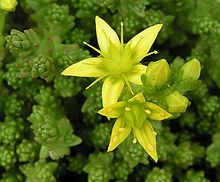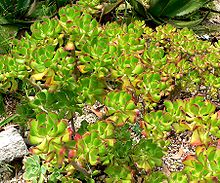- Sedum
-
Sedum 
Biting Stonecrop (Sedum acre) Scientific classification Kingdom: Plantae (unranked): Angiosperms (unranked): Eudicots (unranked): Core eudicots Order: Saxifragales Family: Crassulaceae Subfamily: Sedoideae Tribe: Sedeae Subtribe: Sedinae Genus: Sedum
L.[1]Species Many, see text & Wikispecies for more.
Synonyms - Aithales Webb & Berthel.
- Aizopsis Grulich
- Amerosedum Á.Löve & D.Löve
- Anacampseros Mill.
- Asterosedum Grulich
- Breitungia Á.Löve & D.Löve
- Cepaea Fabr.
- Chetyson Raf.
- Clausenellia Á.Löve & D.Löve
- Cockerellia (R.T.Clausen & N.W.Uhl) Á.Löve & D.Löve
- Congdonia Jeps.
- Corynephyllum Rose
- Diamorpha Nutt.
- Etiosedum Á.Löve & D.Löve
- Gormania Britton
- Helladia M.Král
- Hjaltalinia Á.Löve & D.Löve
- Hylotelephium H.Ohba
- Keratolepis Rose ex Fröd.
- Lenophyllum Rose
- Leucosedum Fourr.
- Macrosepalum Regel & Schmalh.
- Meterostachys Nakai
- Mucizonia (DC.) Batt. & Trab.
- Ohbaea V.V.Byalt & I.V.Sokolova
- Oreosedum Grulich
- Parvisedum R.T.Clausen
- Petrosedum Grulich
- Phedimus Raf.
- Pistorinia DC.
- Poenosedum Holub
- Procrassula Griseb.
- Prometheum (A.Berger) H.Ohba
- Pseudorosularia Gurgen.
- Sedastrum Rose
- Sedella Britton & Rose
- Sedella Fourr., nom. inval.
- Spathulata (Boriss.) Á.Löve & D.Löve
- Telmissa Fenzl
- Tetrorum Rose
- Triactina Hook.f. & Thomson
Sedum is a large genus of flowering plants in the family Crassulaceae, members of which are commonly known as stonecrops. It contains around 400 species of leaf succulents that are found throughout the Northern Hemisphere, varying from annual and creeping herbs to shrubs. The plants have water-storing leaves. The flowers usually have five petals, seldom four or six. There are typically twice as many stamens as petals.
A number of species, formerly classified as Sedum, are now a separate genus Hylotelephium.
Well known European Sedums are Sedum acre, Sedum album, Sedum dasyphyllum, Sedum reflexum (also known as Sedum rupestre) and Sedum hispanicum.
Contents
Uses
Ornamental
Many sedums are cultivated as garden plants, due to their interesting and attractive appearance and hardiness. The various species differ in their requirements; some are cold-hardy but do not tolerate heat, some require heat but do not tolerate cold.
As food
The leaves of all stonecrops are edible.[2]
Sedum reflexum, known as "prickmadam," "stone orpine," or "crooked yellow stonecrop," is occasionally used as a salad leaf or herb in Europe, including the United Kingdom.[3] It has a slightly astringent sour taste.
Sedum divergens, known as "spreading stonecrop," was eaten by First Nations people in Northwest British Columbia. The plant is used as a salad herb by the Haida and the Nisga'a people. It is common in the Nass Valley of British Columbia.[4]
Medicinal
Biting Stonecrop (Sedum acre) contains high quantities of piperidine alkaloids (namely (+)-sedridine, (-)-sedamine, sedinone and isopelletierine), which give it a sharp, peppery, acrid taste and make it somewhat toxic. S. acre was used to treat epilepsy and skin disease, as well as induce miscarriage in ancient Greece. Outright consumption may cause irritations of the mucous membranes, cramps, paralysis, and respiratory paralysis.
Roofing
Sedum can be used to provide a roof covering in green roofs,[5] where they are preferred to grasses.[6] Ford's Dearborn Truck Plant’s living roof has 10.4 acres (42,000 m2) of sedum. Rolls-Royce Motor Cars plant in Goodwood, England has a 22,500 square metres (242,000 sq ft) roof complex covered in sedum, the largest in the United Kingdom.[7]
Ecology
Sedum species are used as food plants by the larvae of some Lepidoptera species including Grey Chi. In particular, Sedum spathifolium is the host plant of the endangered San Bruno elfin butterfly of San Mateo County, California.
Species
- Sedum acre – Wall-pepper, Goldmoss Sedum, Goldmoss Stonecrop, Biting Stonecrop
- Sedum adolphii – Golden Sedum
- Sedum aizoon – Aizoon Stonecrop
- Sedum albomarginatum Clausen – Feather River Stonecrop
- Sedum album – White Stonecrop
- Sedum allantoides
- Sedum allantoides var. goldii
- Sedum alpestre
- Sedum anacampseros – Love-restorer
- Sedum anglicum – English Stonecrop
- Sedum annuum – Annual Stonecrop
- Sedum atratum – Dark Stonecrop
- Sedum australe
- Sedum bithynicum – Turkish sedum
- Sedum burrito – Baby Burro's-tail
- Sedum caeruleum
- Sedum caespitosum
- Sedum candollei
- Sedum cauticola
- Sedum cepaea – Pink Stonecrop
- Sedum clavatum
- Sedum cockerellii Britt. – Cockerell's Stonecrop
- Sedum compressum
- Sedum confusum – Lesser Mexican-stonecrop
- Sedum chazaroi P.Carrillo & J.A. Lomelí
- Sedum dasyphyllum – Thick-leaved Stonecrop
- Sedum debile S.Watson – Orpine Stonecrop, Weakstem Stonecrop
- Sedum dendroideum Moc. & Sessé ex A.DC. – Tree Stonecrop
- Sedum diffusum S.Watson
- Sedum divergens S.Watson – Spreading Stonecrop
- Sedum eastwoodiae (Britt.) Berger – Red Mountain Stonecrop
- Sedum ellacombeanum – Stonecrop
- Sedum ewersii
- Sedum erythrostictum syn. Hylotelephium erythrostictum
- Sedum fosterianum – Rock Stonecrop
- Sedum furfuraceum
- Sedum glaucophyllum Clausen – Cliff Stonecrop
- Sedum havardii Rose – Havard's Stonecrop
- Sedum hirsutum
- Sedum hispanicum – Spanish Stonecrop
- Sedum hybridum – Hybrid Stonecrop
- Sedum integrifolium Entireleaf Stonecrop
- Sedum iwarenge
- Sedum japonicum – Tokyo Sun Stonecrop
- Sedum kamtschaticum Fisch. & C.A.Mey. – Orange Stonecrop, Kamschatka Stonecrop
- Sedum kostovii
- Sedum kamtschaticum cv. 'Weihenstephaner Gold' (formerly Sedum floriferum)
- Sedum lanceolatum Torr. – Lance-leaf Stonecrop, Lanceleaf Stonecrop, Spearleaf Stonecrop
- Sedum laxum (Britt.) Berger – Roseflower Stonecrop
- Sedum leibergii Britt. – Leiberg Stonecrop
- Sedum liebmannianum
- Sedum lineare – Needle Stonecrop
- Sedum lucidum
- Sedum lydium – Least Stonecrop
- Sedum makinoi Golden Japanese Sedum
- Sedum maximum
- Sedum mexicanum Britt. – Mexican Stonecrop
- Sedum moranense – Red Stonecrop
- Sedum moranense Kunth – Red Stonecrop
- Sedum moranii Clausen – Rogue River Stonecrop
- Sedum morganianum – Donkey Tail, Burro Tail
- Sedum nanifolium Fröd. – Dwarf Stonecrop
- Sedum nevii Gray – Nevius' Stonecrop
- Sedum niveum A.Davids. – Davidson's Stonecrop
- Sedum nussbaumerianum
- Sedum nuttallianum Raf. – Yellow Stonecrop
- Sedum oblanceolatum Clausen – Oblongleaf Stonecrop
- Sedum obtusatum Gray – Sierra Stonecrop
- Sedum obtusatum ssp. paradisum Denton – Paradise Stonecrop
- Sedum ochroleucum Chaix – European Stonecrop
- Sedum oreganum Nutt. – Oregon Stonecrop
- Sedum oregonense (S.Watson) M.E.Peck – Cream Stonecrop
- Sedum pachyphyllum
- Sedum pallescens
- Sedum palmeri
- Sedum paradisum Denton – Canyon Creek Stonecrop
- Sedum pinetorum Brandeg. – Pine City Stonecrop
- Sedum praealtum DC. – Greater Mexican stonecrop, Green Cockscomb
- Sedum pulchellum Michx. – Widow's-cross
- Sedum pusillum Michx. – Granite Stonecrop
- Sedum radiatum S.Watson – Coast Range Stonecrop
- Sedum reflexum – Reflexed Stonecrop, Blue Stonecrop, Jenny's Stonecrop, Prick-madam
- Sedum reptans
- Sedum rubrotinctum – Pork and Beans, Christmas Cheer, Jellybeans
- Sedum rubrotinctum cv. 'Aurora'
- Sedum rupicola G.N.Jones – Curvedleaf Stonecrop
- Sedum rupicolum G.N.Jones
- Sedum sarmentosum Bunge – Stringy Stonecrop
- Sedum sediforme Pale Stonecrop
- Sedum sexangulare – Tasteless Stonecrop
- Sedum sieboldii – Siebold's stonecrop
- Sedum smallii
- Sedum spathulifolium Hook. – Broadleaf Stonecrop, Colorado Stonecrop
- Sedum spurium – Caucasian Stonecrop, Dragon's Blood Sedum, Two-row Stonecrop
- Sedum stahlii – Coral Beads
- Sedum stellatum – Starry Stonecrop
- Sedum stelliforme S.Watson – Huachuca Mountain Stonecrop
- Sedum stenopetalum Pursh – Wormleaf Stonecrop, Yellow Stonecrop
- Sedum stoloniferum Gmel. – Lesser Caucasian Stonecrop, Stolon Stonecrop
- Sedum ternatum Michx. – Woodland Stonecrop
- Sedum takesimense
- Sedum torulosum
- Sedum uniflorum
- Sedum valens[8]
- Sedum villosum – Hairy Stonecrop, Purple Stonecrop
- Sedum weinbergii
- Sedum wrightii Gray – Wright's Stonecrop
Formerly placed here
 Hylotelephium telephium ssp. maximum, formerly placed in Sedum
Hylotelephium telephium ssp. maximum, formerly placed in Sedum
Now in Dudleya:
- Dudleya caespitosa (as S. cotyledon)
- Dudleya edulis (as S. edule)
Now in Hylotelephium:
- Hylotelephium spectabile (as S. spectabile)
- Hylotelephium telephioides (as S. telephioides)
- Hylotelephium telephium (as S. carpaticum, S. fabaria or S. telephium)
Now in Rhodiola:
- Rhodiola rhodantha (as S. rhodanthum)
- Rhodiola rosea (as S. rosea, S. rhodiola or S. scopolii)
- Rhodiola pachyclados ( S. pachyclados)
References
- ^ "Sedum L.". Germplasm Resources Information Network. United States Department of Agriculture. 2006-11-03. http://www.ars-grin.gov/cgi-bin/npgs/html/genus.pl?11032. Retrieved 2010-04-28.
- ^ Plants of Coastal British Columbia, including Washington, Oregon, & Alaska, 2004, Jim Pojar and Andy MacKinnon, p.157
- ^ "Sedum rupestre - L. Crooked Yellow Stonecrop". Plants for a Future. http://www.pfaf.org/database/plants.php?Sedum+rupestre. Retrieved 2010-04-28.
- ^ Plants of Coastal British Columbia, including Washington, Oregon, & Alaska, 2004, Jim Pojar and Andy MacKinnon, p.156
- ^ Monterusso, M. A; Rowe, D. B., Rugh, C. L.. Establishment and persistence of Sedum spp. and native taxa for green roof applications. American Society for Horticultural Science. http://www.cababstractsplus.org/abstracts/Abstract.aspx?AcNo=20053080523. Retrieved 30 June 2009.
- ^ Kalinowski, Tess (August 04, 2009). "Green roof takes root at Eglinton West". Toronto Star. http://www.thestar.com/news/gta/article/675703. Retrieved 2010-05-23.
- ^ "Rolls-Royce - Made in Sussex". Sussex Life. October 25, 2010. http://sussex.greatbritishlife.co.uk/article/rolls-royce-made-in-sussex-goodwood-bmw-26150/. Retrieved 2010-11-19.
- ^ Björk, C. (2010). Sedum valens (Crassulaceae), a new species from the Salmon River Canyon of Idaho. Madroño 57:2 136.
External links
 Media related to Sedum at Wikimedia Commons
Media related to Sedum at Wikimedia Commons  Data related to Sedum at WikispeciesCategories:
Data related to Sedum at WikispeciesCategories:- Sedum
- Garden plants
- Medicinal plants
Wikimedia Foundation. 2010.









